Private James Masterton
S/18387, 8th Black Watch (Royal Highlanders)
died 15th June 1918
aged 20
Meteren Military Cemetery
Dunfermline War Memorial
Son of George Masterton and Marion Hunter
Falconer Terrace, Dunfermline, Fife, Scotland
aged 20
Meteren Military Cemetery
Dunfermline War Memorial
Son of George Masterton and Marion Hunter
Falconer Terrace, Dunfermline, Fife, Scotland
Genealogy
James Masterton was born in Dunfermline, Fife in 1898, the eldest of three children born to George Masterton, a railway signalman, and Marion Hunter who had married in 1896 in Dunfermline. His mother Marion died in March 1907 in childbirth and George remarried, to Margaret Calderhead, in 1908. In 1911 James, then aged 12, was living with the family in Dunfermline, a scholar at Pittencrieff Public School, his last day there being 28th June 1912.
Further details of James, and the extended family of Mastertons from the Cramond branch can be found at the following link.
His War
James was recruited into the 8th Battalion, the Black Watch (Royal Highlanders). Unless James concealed his true age, he should not have been fighting on the Western Front until he was 19 years old (ie from 1 May 1917).
The 8th (Service) Battalion was formed at Perth on 21 August 1914 as part of K1, and came under command of 26th Brigade, 9th (Scottish) Division. After training at Aldershot, Alton and Bordon, the battalion landed at Boulogne in May 1915.
The 9th (Scottish) Division fought at Loos, the Somme, Arras, Third Ypres (Passchendaele) Cambrai, the German Spring Offensive, and after a few weeks resting and reorganising near St Omer, in June 1918 it was holding a section of the front near Meteren in North East France close to the Belgian border. On the night of 14th/15th June 1918, a night raid was carried out, in the spirit of "active defence", to attempt to take prisoners to secure identification of the opposing German battalions, and this was most likely the action in which James lost his life.
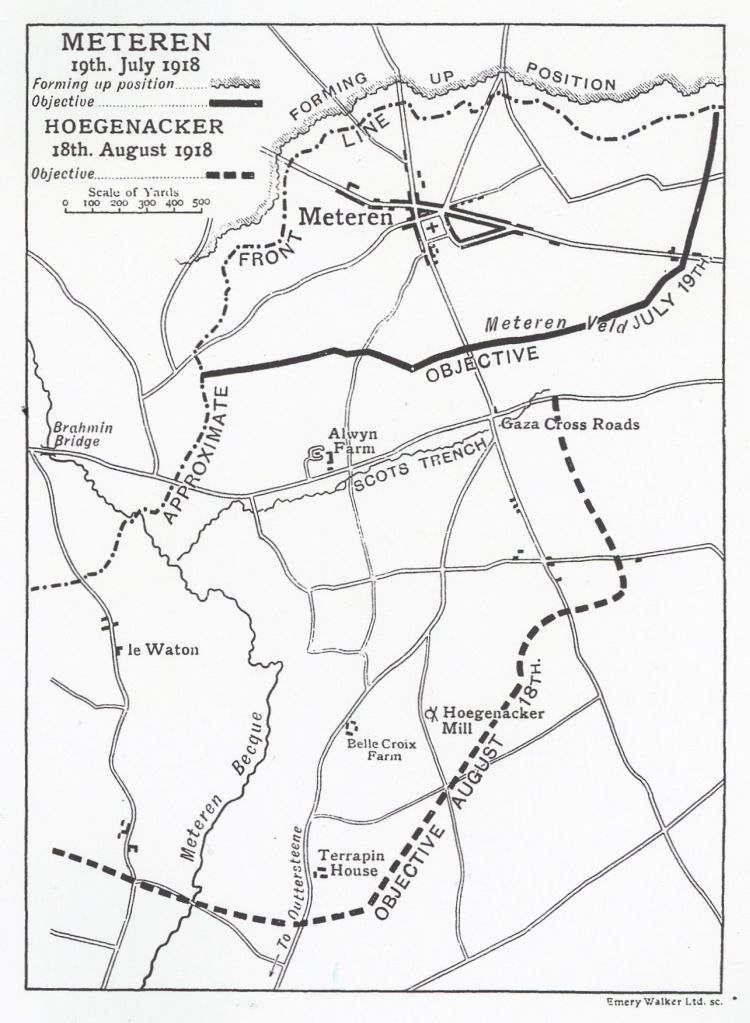
James Masterton was killed in a night raid from the front line before the main attack on Meteren on 19th July 1918
The History of the Ninth (Scottish) Division 1914-1919
On the whole, the Ninth found the sector a very pleasant one to hold and our casualties from the enemy's artillery fire were not very high. The landscape was typically agricultural and consisted of wide fields of long waving corn, coloured in patches by the bright red of the poppy, with a few substantial farmhouses interspersed here and there. So hurried had been the flight of the civilians from the district that at many of the farms some live-stock had been left, and in one portion of the line two cows were regularly handed over on reliefs as part of the trench stores.
The attitude of the Division was one of active defence. Patrolling was assiduous; screened by the tall corn, small parties left our lines every day to examine the enemy's positions. Raids for the purpose of securing identifications were constantly carried out, and as the youngsters of the Division gained experience and learned the lie of the country they became adepts in the art of surprising posts. Abortive attempts to take prisoners were made by the K.O.S.B. on the night of 2nd/3rd June, the 12th Royal Scots on the 10th, and the Black Watch on the night of the 14th/15th, but during these forays several Germans were killed and wounded.
In June alarm was caused by a distressing outbreak of trench fever which affected the whole Division; numerous officers and men were removed to hospital, but the attack proved to be as short as it was sharp, and in the majority of cases the patients were able to rejoin their units after a fortnight's absence.
The History of the Ninth (Scottish) Division 1914-1919
John Ewing
John Murray, London
1921
pp 321-322
Unit War Diary: 8th Black Watch (Royal Highlanders)
11/6/18: On night 11/12th Battalion was relieved in Support position, Right Sector by 2nd Bn, Royal Scots Fusiliers (South African Brigade.) On relief Battalion moved to relief of 6th Bn King's Own Scottish Borderers on Left Sector, becoming Left Front Battalion.
Companies were disposed as follows:
Left Front - "A" Company
Support - "C" Company
Reserve - "B" Company
Casualties - Nil. Major I.W.W. SHEPHERD, M.C. evacuated sick.
13/6/18: Lieut J.L. YOUNG, M.C. and 2/Lt R.L. BROWN rejoined from hospital.
14/6/18: Casualties. Killed 1 O.R; Wounded 1 O.R.
On night 14/15th June, a minor operation was undertaken with the effect of securing identifications - see Appendix 1 attached.
Casualties - Killed - 2/Lieut M.S. STUART & 4 O.R.s
A/Capt N.A. SOUTAR, M.C. evacuated sick. Wounded - 5 O.R.s
15/6/18: 2/Lieuts J.M. McDONALD & W.R.W. LOUDEN evacuated sick 15th. 2/Lieuts T.D. DON and A.M. LAING on 16th.
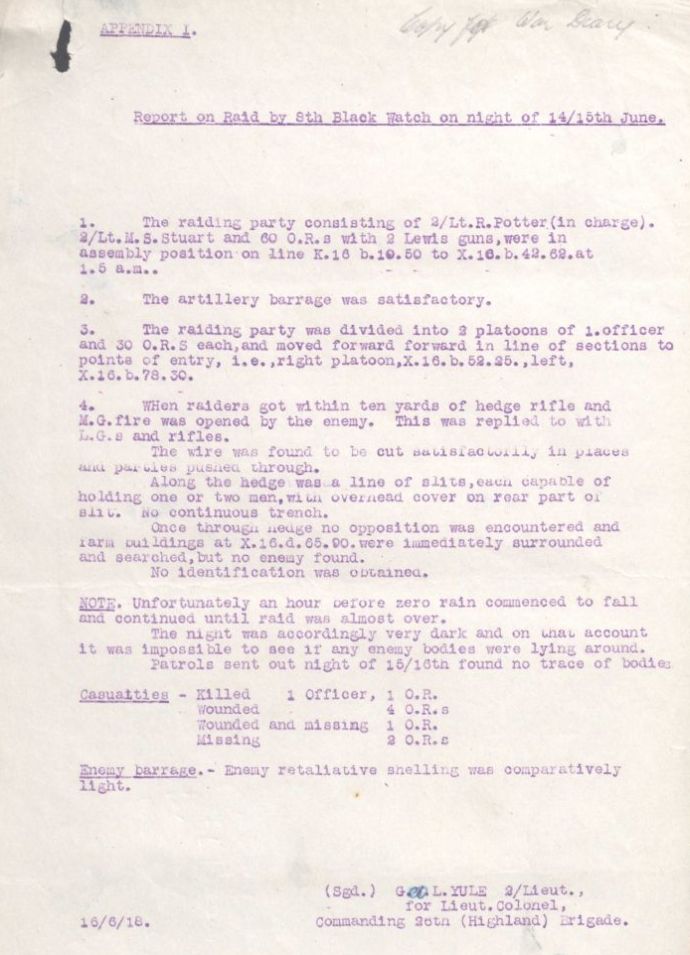
National Archives
Kew, London
WO 95/1766/3
26 Infantry Brigade: 8 Battalion Black Watch (Royal Highlanders)
Jan 1918 - Sep 1918
James is buried in Meteren Military Cemetery, and is also commemorated on the civic memorial of his home town of Dunfermline and on his family headstone in Dunfermline Cemetery (as Lance Corporal).
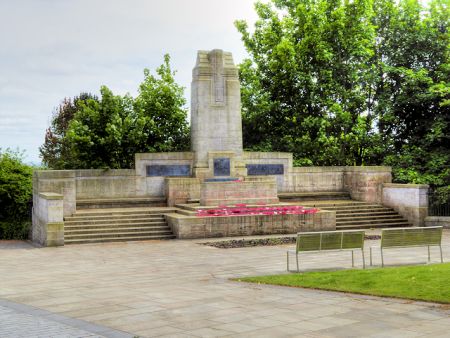
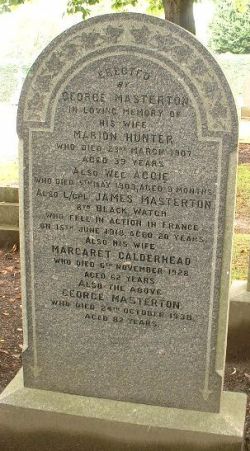
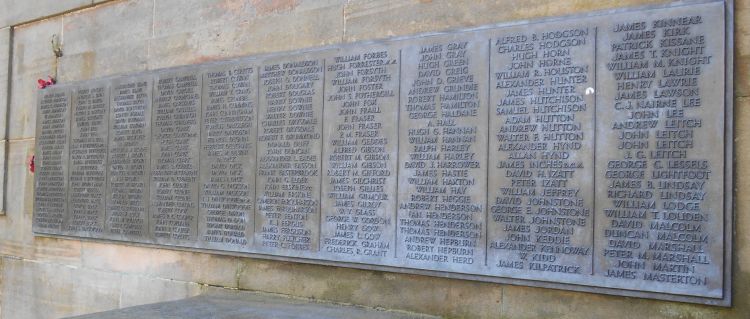
James Masterton is at extreme bottom right of this panel of Dunfermline War Memorial
Other Sources
- James Masterton discharge from Pittencrieff School
- James Masterton's Deceased Soldier's Effects
- Commonwealth War Graves Commission
- James Masterton Medal Index Card
- James Masterton Medal Roll
- War Diaries: 26 Infantry Brigade: 8 Battalion Black Watch (Royal Highlanders) Jan 1918 - Sep 1918. National Archives WO 95/1766/3.
- James Masterton in IWM Lives of First World War
- Medals: Victory, British War